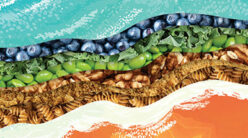When I think of cancer, my mind takes a stroll down memory lane. I see scores of women and children-women diagnosed with breast, ovarian, or uterine cancer; children fighting leukemia, bone cancers, or muscle sarcomas.
During a routine examination I found an enlarged kidney containing a renal cell cancer in one middle-aged woman. Another patient’s pelvic adenopathy alerted me to the diagnosis of malignant lymphoma.
I also think of my dad and his battle with prostate cancer.
In moments of reflection I recall a 32-year-old colleague who came to me for her routine checkup. Her pap smear revealed atypical cells suggestive of malignancy. My investigations, increasingly complex, failed to reveal the source. Eventually I laparoscoped her, closely examining her ovaries and pelvic organs. Everything looked fine-except for a peanut-sized lesion on an ovary. I carefully and meticulously scanned the peritoneum, and some tiny salt grain irregularities caught my eye. These I biopsied.
Imagine my sorrow in having to communicate a diagnosis of widespread peritoneal and ovarian cancer. Imagine my patient’s difficulties in her two-year losing battle for survival. Imagine the heartbreak that entered the life of the young child she left behind.
How it All Begins
If prevention were understood and easy, these cases might not have occurred. Advances in understanding evolve daily. The new vaccine against human papilloma virus may well reduce cervical cancer to a fraction of its current prevalence. Screening procedures employed by many physicians are directed at detecting malignant change before it can spread. Yet despite all these diagnostic and therapeutic advances, prevention obviously is the optimal approach.
Some clear-cut relationships exist. There’s an infallible link between smoking and cancer. To escape smoking-related cancers, simply don’t smoke!
But many other cancers don’t reveal such obvious correlated
causes. This begs the question Can we alter our risk of cancer? According to current information, there’s a definite role for diet to play in reducing some cancer risks. Same with exercise. Also, abstaining from both tobacco and alcohol products should most certainly be part of anybody’s arsenal of prevention.
Cancer is not a specific or single disease. Each type is specific to the tissue in which it arises. But all cancers share certain common features. The cellular division in cancer is uncontrolled and rapid, leading the cells to lose their tissue specificity to a greater or lesser extent. The stickiness between cells is reduced, making them more able to break off and migrate to other organs and tissues, where new colonies of cancer (metastases) may grow.
The deoxyribonucleic acid (DNA) of the cell nucleus regulates cell division. Modification or damage to the DNA may interfere with this regulation. The actual division of cells requires several nutrients, such as cofactors (vitamins) and proteins. In light of this fact, it’s perfectly logical to ask whether diet could play a role in either the prevention or causation of cancer.
Food for Thought
Some specific cancers are difficult to study because their prevalence and incidence in a community can be so low that valid deductions are not possible. A concept of relative risk permits the evaluation of dietary effects against controlled or general background populations. Factors of genetics, environment, and lifestyle have to be balanced out so as to reduce the chance of their interfering with results. This making of “all other things equal” isn’t easy. The risk, usually over a one-year period, of a cancer in a population eating the diet under consideration is compared to the risk in another population matched for other factors, such as age, gender, etc. A relative risk of 1 means there’s no difference. Less than 1 = less risk; more than 1 = more risk.
Dietary factors are prime targets for observation because there are many ways they can affect us. Most have direct contact with the digestive tract. Some influence bowel transit time. Some alter the biochemical environment by influencing the chemistry of colonic fluids and the metabolic activity of colonic bacteria. Some increase concentrations of fatty acids and secondary bile acids, which may decrease the risk of rapid cellular proliferation.
Protective factors, such as vitamins, flavonoids, and certain minerals, can influence the cellular function of cells within the body’s internal organs. Foods may contain compounds known to be carcinogenic (cancer-causing)-for example, nitrosamines, produced in meat as it is heated to high temperatures, perhaps over a barbecue. Other foods may contain enzymes that protect by breaking down carcinogens. An example would be the isothiocyanates of cruciferous vegetables (broccoli, cabbage, brussels sprouts, etc.).
Fruits and vegetables contain a number of antioxidants, such as vitamin C, beta-carotene, vitamin E, and flavonoids. These could theoretically be anticarcinogenic through reducing DNA damage done by oxidizing free radicals. Vitamin C reduces the conversion of nitrites and nitrates to nitrosamines, thus lessening the risk of this carcinogen. Folic acid assists in the synthesis of DNA, thus helping to keep the cells’ nuclei healthy. Some substances may engage tissue hormone receptors, then either stimulate or block functions that may modify a cell division. Lignin (found in grains and seeds) and isoflavones (found in legumes) contain these phytoestrogens and could influence breast or prostate tissues.
Insulin Resistance Factor
Another potential cancer-promoting factor is obesity. This unfortunate and now widespread condition is often associated with insulin resistance in the tissues, which leads to high blood insulin levels. Some studies have suggested that higher insulin levels may correlate to increased cancer risk, so regular consumption of food with a high glycemic index, i.e., rapidly rising blood sugars, might be associated with persistently increased insulin levels. Examples of foods with high glycemic indices are white rice, refined flours, potatoes, and refined sugar. On the other hand, complex carbohydrates-as found in whole foods such as beans, grains, and nuts-are much less likely to cause elevated insulin levels. Keep in mind that obesity promotes higher insulin levels by creating tissue insulin resistance.
Vitamin D metabolites have been shown to reduce the rate of cell
division in many tissues. Dietary vitamin D influences blood levels, and could affect the rates of cancer in both animals and humans.
An association between meat eating and cancer has been uncovered in several studies. Increased risk of cancer of the stomach, colon, rectum, pancreas, bladder, breast, uterus, and ovary have been noted in those who eat more meat. Whether persons eating a high meat diet have reduced intake of the protective fruits and vegetables-is not absolutely clear at this point.
Now let’s examine known dietary correlation with common cancers of specific organs.
Colon Cancer
Nearly 100,000 new cases occur per year in the United States, with some 48,000 deaths per year. A five-year survival rate of 63 percent makes this a serious condition.
Drs. Singh and Fraser reported in the American Journal of Epidemiology that colon cancer increased with the consumption of meats. Both red and white meats were associated with increased risk, with white meats leading the charge. The same investigation found that protection against colon cancer lay in the legume food group (beans, chickpeas, lentils, etc.).
According to the Adventist Health Study-an ongoing examination of members of the Seventh-day Adventist Church (a denomination whose constituents tend to be very health conscious)-a nonvegetarian low-legume-consuming obese male has a 5.1 times greater risk of colon cancer than a lean vegetarian who may also rarely eat legumes.
Calcium and folate are thought to reduce colon cancer risk too, which may explain some of the studies showing that selected dairy products have a colon cancer protective effect.
Prostate Cancer
Though more prevalent (198,000 new cases per year) than colon cancer, prostate cancer is associated with fewer deaths (31,500 patients).
The prostate is a sex-hormone-responsive organ, so prostate cancer can theoretically have an intervention window of opportunity through this avenue.
Phytoestrogens found in foods have been suggested as potential mediators of effect on prostate cancer development. Studies have reported dietary relationships with prostate cancer, such as greater risks with meat and fish intake; and reduced risks with dried fruits, citrus, nuts, tomatoes, and legumes. Yet it should be noted that careful multivariate analysis failed to confirm these suggestions.
In considering the evidence, one must understand that the number of cases involved in a study, the ability to control variables, and the statistical weight of the evidence make it clear that not all studies are reliable. This is why anyone interested in the subject of health must carefully consider the claims of enthusiasts who pick up any study that supports their claim. Such reckless use of data may eventually harm the acceptance of good and useful practices, which in the long run is counterproductive.
While calcium has been indicated as reducing colon cancer, it has been suggested, but on rather weak evidence, that there may be a link between increased calcium intake and prostate cancer.
On the topic of prostate cancer, a small subgroup of Adventist men mentioned in the Adventist Health Study, who were drinking more than one glass of soy milk per day, enjoyed a protective effect. Though a small study, this dovetails nicely with the report from a 1989 study that noted a protective effect related to tofu intake of more than five portions per week.
Breast Cancer
Female breast cancer is clearly related to factors such as the maternal history of breast cancer, the age at which the first child was born and the age of menstruation (the risk increases with age), the age at menopause (increased risk with age), and education level (again, increasing with an increased level).
Ecological studies have shown that different countries have different rates of breast cancer, but picking the contributing factors from multiple possible causes is not easy. Other factors being considered include fat intake, animal products, soy products, fruits, and vegetables.
There is inconclusive evidence that meat consumption influences the risk of breast cancer, and though fat has been suggested as playing a causative role, pooled analysis of seven studies could not provide conclusive evidence that more fat changed the risk of breast cancer.
Soy products may protect against breast cancer through their phyto-estrogens, or by reducing blood estrogen levels.
Examining all the evidence available to date, I could summarize by saying that there’s no convincing association between diet and breast cancer.
To get more copies of How to Fight Cancer for Life, the special sharing issue that includes this article, click here.






